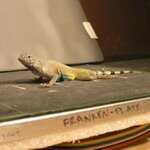Ecology & Zoology

JACKSON HOLE, Wyoming, May 8 /PRNewswire/ --
- Snake River Sporting Club Achieves Full Compliance with Construction and Development Conditions Issues By U.S. Army Corps of Engineers' Permit For Development Near An Endangered Species
Snake River Sporting Club, the private residential sporting community in Jackson Hole, Wyoming, has received official documentation from The U.S. Army Corps of Engineers (USCAE) as having preserved and conserved native bald eagle habitats on the sporting club grounds during construction.
The USCAE, responsible for investigating, developing and maintaining the…

Investigations continue into the cause of a mysterious illness that has resulted in the deaths of thousands of bats since March 2008. At more than 25 caves and mines in the northeastern U.S, bats exhibiting a condition now referred to as “white-nosed syndrome” have been dying.
The U.S. Geological Survey (USGS) recently issued a Wildlife Health Bulletin, advising wildlife and conservation officials throughout the U.S. to be on the lookout for the condition known as “white-nose syndrome” and to report suspected cases of the disease.
USGS wildlife disease specialist Dr. Kimberli Miller advises…

Scientists used to think that hermaphrodites, due to their low position in the evolutionary scale, did not have sufficiently developed sensory systems to assess the “quality” of their mates.
A new work has shown, however, that earthworms are able to detect the competition by fertilising the eggs that is going to find its sperm, tripling its volume when there is rivalry. This ability is even more refined as they are able to transfer more sperm to more fertile partners.
Hermaphrodites, organisms that have both female and male reproductive organs, such as earthworms, are denied the right to…

Think it's tough for humans to find the right mate? Malagasy mouse lemurs are so similar that picking a mate of the right species, especially at night time in a tropical forest, was thought to be more luck than science, but new research has shown that our desperately cute distant cousins use vocalizations to pick up a partner of the right species.
Until recently, grey, golden brown, and Goodman’s mouse lemurs were all thought to be the same species. But genetic testing revealed that they are, in fact, three distinct, species so similar that they cannot be told apart by their appearance—so…

It seems rumors of the greater dwarf cloud rat's demise have been greatly exaggerated. Sure, he stayed low key for the last 112 years but he really never left his natural habitat.
Seeing the little guy once and then declaring him extinct was likely premature.
Carpomys melanurus, the greater dwarf cloud rat, has dense, soft reddish-brown fur, a black mask around large dark eyes, small rounded ears, a broad and blunt snout, and a long tail covered with dark hair. An adult weighs about 185 grams.
"This beautiful little animal was seen by biologists only once previously - by a British…

Using microphone arrays and photographic methods to reconstruct flight paths of bats in the field when they find and capture prey in air using their sonar system, Annemarie Surlykke from the Institute of Biology, SDU, Denmark, and her colleague, Elisabeth Kalko, from the University of Ulm, estimated the emitted sound intensity and found that bats emit exceptionally loud sounds exceeding 140 dB SPL (at 10 cm from the bat's mouth), which is the highest level reported so far for any animal in air.
For comparison, the level at a loud rock concert is 115-120 dB and for humans, the threshold of…

Because dogs didn't exist back then, more relevant analogies had to be used in that title. Why? Because analyses of Chengjiang and Burgess Shale food-web data suggest that most, but not all, aspects of the trophic structure of modern ecosystems were in place over a half-billion years ago.
The ecology of Cambrian communities was remarkably modern, say researchers behind the first study to reconstruct detailed food webs for ancient ecosystems. Their paper suggests that networks of feeding relationships among marine species that lived hundreds of millions of years ago are remarkably similar to…

Researchers at the University of Cincinnati and Florida State University have confirmed evidence of domesticated sunflowers in Mexico — 4,000 years before what had been previously believed.
“People sometimes ask “What is the big deal about sunflower?” says David Lentz, professor of biological sciences and executive director of the Center for Field Studies in the McMicken College of Arts & Sciences at the University of Cincinnati (UC). Lentz worked with Mary Pohl from Florida State University, José Luis Alvarado from Mexico’s Institute of Anthropology and History, and Robert Bye from the…

As you might expect, much of the evolution of how lizards move is related to getting food.
A research team led by Ohio University doctoral student Eric McElroy tracked 18 different species of lizards as they walked or ran in order to understand how their foraging styles impact their biomechanics. The study, funded by the National Science Foundation, was featured in the April 1 edition of the Journal of Experimental Biology.
Lizards use two basic foraging techniques. In the first approach, aptly dubbed sit-and-wait, lizards spend most of their time perched in one location waiting for their…

Female mice can steer clear of inbred males on the basis of their scent alone, according to evidence in Current Biology.
The researchers found that female mice chose to associate with males producing a greater diversity of major urinary proteins (MUPs), even when all else was held equal. An earlier study by the same team had shown that wild mice also rely on MUPs to recognize and avoid mating with their close relatives.
Inbreeding is often avoided in animals because it can lead faulty, otherwise hidden (or recessive) traits to surface in their offspring. Nevertheless, Thom said, inbreeding…